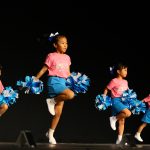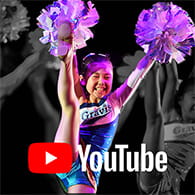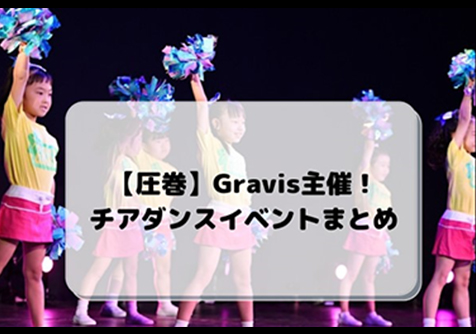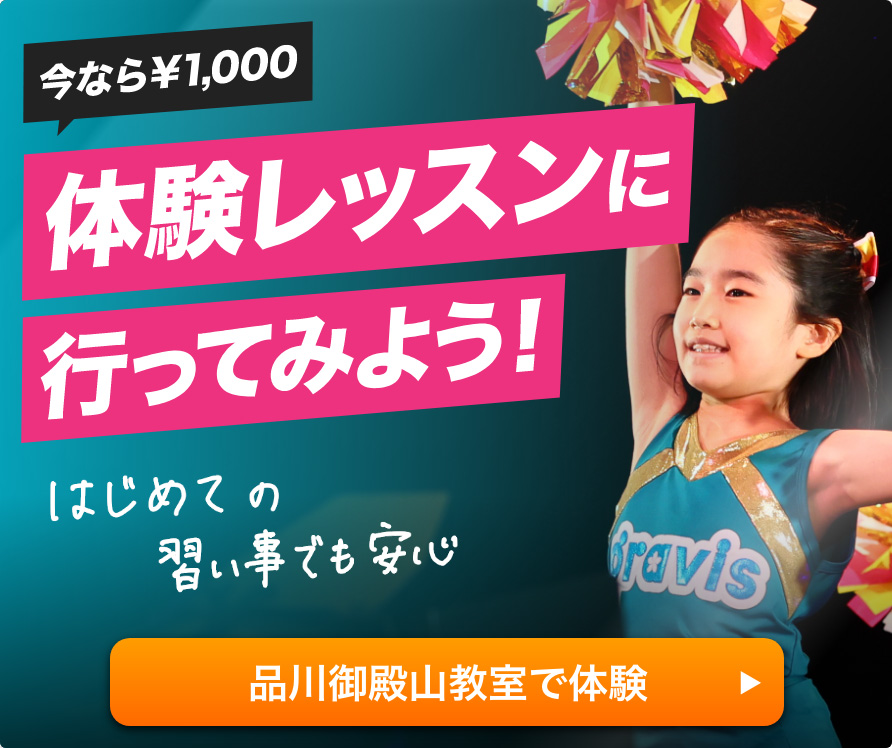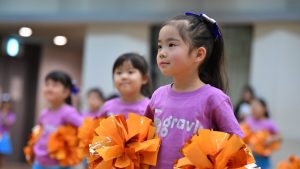
Hello to everyone looking for kids’ cheer activities in Torrance area!
In the city of Torrance, it’s not uncommon to hear Japanese spoken on the streets, as the area is home to a large Japanese community.
With plenty of Japanese supermarkets, clinics, dental offices, beauty salons, and hotels, it’s a comfortable and convenient place to live, which makes it especially popular among Japanese residents.
Torrance is also known for its safety, ranking among the safest cities in the United States.
In this article, we’ll introduce kids’ cheer schools in Torrance area that welcome children from preschool age!
目次
- 1 What is Cheer Dance?
- 2 2 Kids’ Cheer Schools in Torrance Area
- 3 Where Do Students Come From?
- 4 No cheer school nearby? Here’s what to do…
- 5 Frequently Asked Questions from Those Who Want to Learn Cheer Dance
- 6 Summary
What is Cheer Dance?
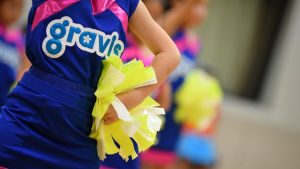
Have you ever heard of cheer dance?
Cheer dance is a sport derived from cheerleading.
In the U.S., it is commonly called “Pom Dance” or simply “Dance,” and it has become an established competitive sport in its own right.
Interestingly, the term “cheer dance” itself was actually coined in Japan!
Cheer dance combines three dance styles—pom dance, hip-hop, and jazz—into a performance of about two minutes.
If you want to learn more about cheer dance, be sure to check out What Kind of Dance is Cheer Dance?
The Difference Between Cheer Dance and Cheerleading
Cheerleading is said to have originated about 100 years ago at American universities to support their school football teams. At first, it was mainly done by male students as a form of vocal cheering.
The style we see today, featuring women performing dance routines, was established roughly 30 years ago.
Cheerleading as a sport focuses on acrobatic skills such as stunts (human pyramids) and tumbling (floor gymnastics).
Cheer dance, on the other hand, takes the dance portion of cheerleading and makes it a separate competitive sport.
In competitions, teams perform routines of about two minutes, combining pom dance, hip-hop, and jazz, while being judged on teamwork, expression, and overall performance.
The common point between cheer dance and cheerleading is the “cheer spirit.”
Regardless of which one you do, participants are called “cheerleaders.”
Cheer spirit can be interpreted in many ways, but the Japan Cheer Dance Association defines it as “always cheering for and encouraging others with a smile.”
If you are someone who prefers to avoid acrobatic stunts or wants to develop graceful, fluid movements, cheer dance is highly recommended!
2 Kids’ Cheer Schools in Torrance Area
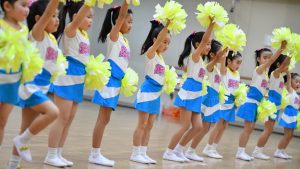
Here’s a summary of kids’ cheer schools in Los Angeles area that accept preschool-aged children!
Gravis Los Angeles – Torrance Cheer Dance Classes
Gravis offers cheer dance classes for children, including preschoolers, with over 150 locations mainly in Tokyo and Kanagawa!
After expanding across Japan, Gravis opened its first overseas location in Los Angeles in February 2024!
Lessons are taught by Japanese instructors for Japanese children, so even kids who aren’t confident in English can easily follow along.
Support is available in both Japanese and English!
Why not start your child’s cheer experience in the home of cheerleading—right here in the U.S.—as an extracurricular activity for kids of expatriates?
| Schedule |
HIP HOP JAZZ CHEER BALLET |
| Age Group | 3 years old and up |
| Fees |
Trial Lesson: $10 |
| Access | 1951 West Carson Street, Torrance, California, 90501 |
Pom Pom Girls
Where Do Students Come From?

Torrance is very accessible by transportation, so many students come from various surrounding areas, including Gardena, Culver City, Manhattan Beach, Compton, Rancho Palos Verdes, and San Pedro.
If you’re unsure which school to choose, consider these points: whether classes are offered at your preferred time, how well your child gets along with the instructor, and the school’s track record.
It’s a good idea to attend a trial lesson or visit the school before deciding!
No cheer school nearby? Here’s what to do…
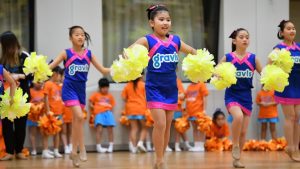
Some of you might not have a cheer school near your home.
In-person lessons definitely have many advantages—you can dance freely in a spacious studio, use mirrors to check your form, and feel the energy of the class firsthand.
However, you also have to consider factors like your family’s schedule and transportation to the studio.
In those cases, online lessons are a great option to start cheer dance easily!
Gravis also offers online lessons, so if you’re interested, be sure to contact the school for more details.
Frequently Asked Questions from Those Who Want to Learn Cheer Dance
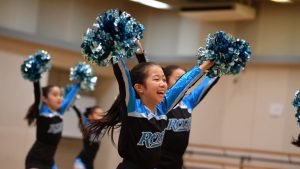
If you’re thinking about starting cheer dance lessons, you might have a lot of questions and concerns, like “Where can I take classes?” or “How much does it cost?”
Here, we’ll explain everything in detail to help ease those worries!
Where Should You Go If You Want to Learn Kids’ Cheer Dance?
Kids’ cheer dance schools (classes) can be broadly divided into three types, depending on the purpose—such as “where you’ll perform” or “what you want to aim for.”
①Schools Where You Can Take Cheer Dance Classes
If you’re just starting out and want to learn cheer dance as your first extracurricular activity, a school specializing in cheer dance, a large sports gym, a cultural center, or a dance school with cheer dance classes is perfect!
In lessons, children learn the basics of cheer dance, including body conditioning, arm motions (unique cheer dance movements), techniques (turns, jumps, etc.), and choreography.
Some schools also offer opportunities to perform at recitals, competitions, or local events.
- If you just want to enjoy learning cheer dance
- If you want to learn the basics of cheer dance
- If you like moving your body
…then look for a nearby cheer dance school or check if sports gyms, cultural centers, or dance schools in your area offer cheer dance classes.
②Club Teams
A club team is a type of organization run not by a company but by a group of enthusiasts who organize and manage it themselves.
Cheer dance can be roughly divided into competitive cheer and cheering for sports.
Club teams mainly aim to compete in cheer dance competitions hosted by organizations such as the Japan Cheer Dance Association or CHEER&DANCE Education.
Competitions bring together teams from all over Japan, where performance and technical skills are judged.
Top-level teams can even earn the right to compete in world championships.
To aim for high ranks in competitions, teams practice not only basic skills but also advanced techniques, requiring both technical ability and mental strength. Training can sometimes be intense.
Because club teams are self-managed, operational costs and cooperation from parents are often necessary, which can mean a greater commitment for families.
- If you want to aim for a high level in cheer dance
- If you want parents to be actively involved
…then a club team is recommended.
③Sports Team-Affiliated Cheer Dance Schools
Sports team-affiliated cheer dance teams are tied to specific sports teams—baseball, soccer, basketball, or football—and focus on learning performance for sports cheering rather than competing in competitions.
Students learn to lead cheers, energize the crowd through performances, and support their own team.
Performance styles vary depending on the sport, team, and venue, so look for cheer teams affiliated with sports you like or local teams in your area.
- If you love sports
- If you want to cheer for sports events
…then a sports team-affiliated cheer dance team is perfect!
Recently, many schools—including Gravis—have both competitive teams for competitions and cheering teams for sports events within a single cheer dance school, separating teams based on their goals.
How Much Does It Cost to Take Cheer Dance Lessons?
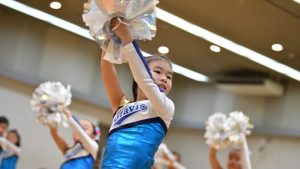
The main costs associated with taking cheer dance lessons include:
①Lesson Fees
・Trial lesson fee for first-time students
・Initial costs (registration fee, administrative fees, etc.)
・Monthly tuition or class passes
②Costume and Equipment Fees
・Pom-poms
・Costumes or uniforms
・Shoes
③Event and Performance Participation Fees
・Fees for local events
・Fees for recitals or showcases
The overall cost of cheer dance lessons varies depending on the school or studio, but it’s generally comparable to regular dance classes (with average monthly tuition around $100–200).
Initial fees and monthly tuition are often listed on the school’s website, so it’s a good idea to check in advance. Participation fees for recitals or events and costume costs may vary each year, so total expenses can fluctuate.
For a detailed breakdown of actual costs at Gravis Cheer Dance School, you can refer to our article on “Benefits and Costs of Cheer Dance for Children.”
What are the benefits of taking cheer dance lessons?
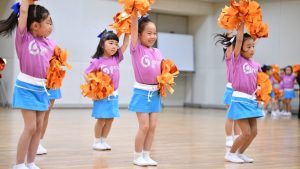
What can you learn from cheer dance among the many dance genres? What are its benefits?
One key difference between cheer dance and other dance styles is that you develop cheer spirit!
Cheer spirit can be interpreted in various ways, but according to the Japan Cheer Dance Association, which organizes nationwide cheer dance competitions in Japan, it is defined as: “always encouraging and energizing others with a smile.”
Here’s a closer look at what Gravis values, which aligns with this cheer spirit.
① Learning Greetings, Responses, and Manners
The word “Cheer” in cheerleader means to support or encourage, and “Leader” means instructor or guide.
To lead others (by being a role model), children are encouraged to take initiative in greetings, responding politely, and everyday actions.
This allows them to practice manners in real situations, more effectively than in typical preschool classes.
② Learning Smiles, Energy, and Expression
To support others, children first learn the importance of smiling themselves.
By performing cheerfully, their energy and smiles create a “chain of smiles,” making the audience and parents happy.
At cheer dance competitions, unlike most sports or dance competitions where participants see each other as rivals, cheer teams actively cheer for other teams from the audience!
While final rankings are given, each team encourages others respectfully so everyone can showcase their hard work.
③ Learning Cooperation and Teamwork
Cheer dance is a team sport.
Performances are not done alone, so children naturally develop the ability to communicate and cooperate with friends and instructors.
By sharing each member’s strengths and weaknesses, supporting each other in both technical and mental aspects, children grow empathy and a sense of community while completing their routines.
④ Developing a Challenging Spirit
As mentioned earlier, a single cheer dance routine combines three dance genres: pom dance, hip-hop, and jazz dance.
In Gravis lessons, children learn all three: pom dance with pom-poms, hip-hop with low-center movements, and jazz dance with lifted movements (including ballet basics).
To master these different styles, children are encouraged to try new moves without fear of failure, fostering a strong willingness to challenge themselves.
If you’re interested in Gravis cheer dance classes, check out the official website!
Summary
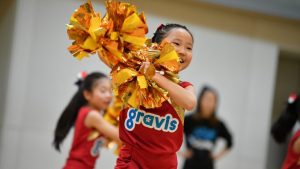
Did any of the kids’ cheer schools catch your interest?
This time, we introduced kids’ cheer schools in Torrance area that welcome students from preschool age!
If you’re interested in Gravis’ cheer dance classes, be sure to join a trial lesson or come for a visit.
Our experienced instructors are looking forward to meeting you!
We hope you find the perfect kids’ cheer school and a fun activity that’s just right for you☆
Related Articles
Gravisロサンゼルスチアダンスクラス情報!メンバー募集中!
トーランスエリアのキッズチアスクール(教室)まとめ
チアダンスって、どんなダンス?
いま大注目のキッズチアダンスについて徹底解説します!
初めての習い事選び~どんな効果を求めますか?~
【子どもの習い事】ダンスにする?チアダンスにする?
【子どもの習い事】チアダンスを習うメリットと費用の詳細をご紹介!
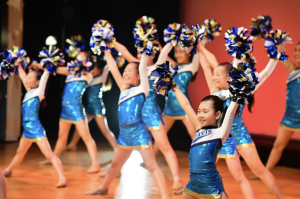
Gravis YouTube Channel
👉 [Gravis Dance & Fitness – YouTube]
Please subscribe to our channel ☆
📩 Email: office@gravis-dance.com
☎︎ +81-50-3131-1065 (Japan line)
Instagram: @gravis_dance_fitness
Facebook: @gravisdancefitness
Twitter: @Gravis_Dance




